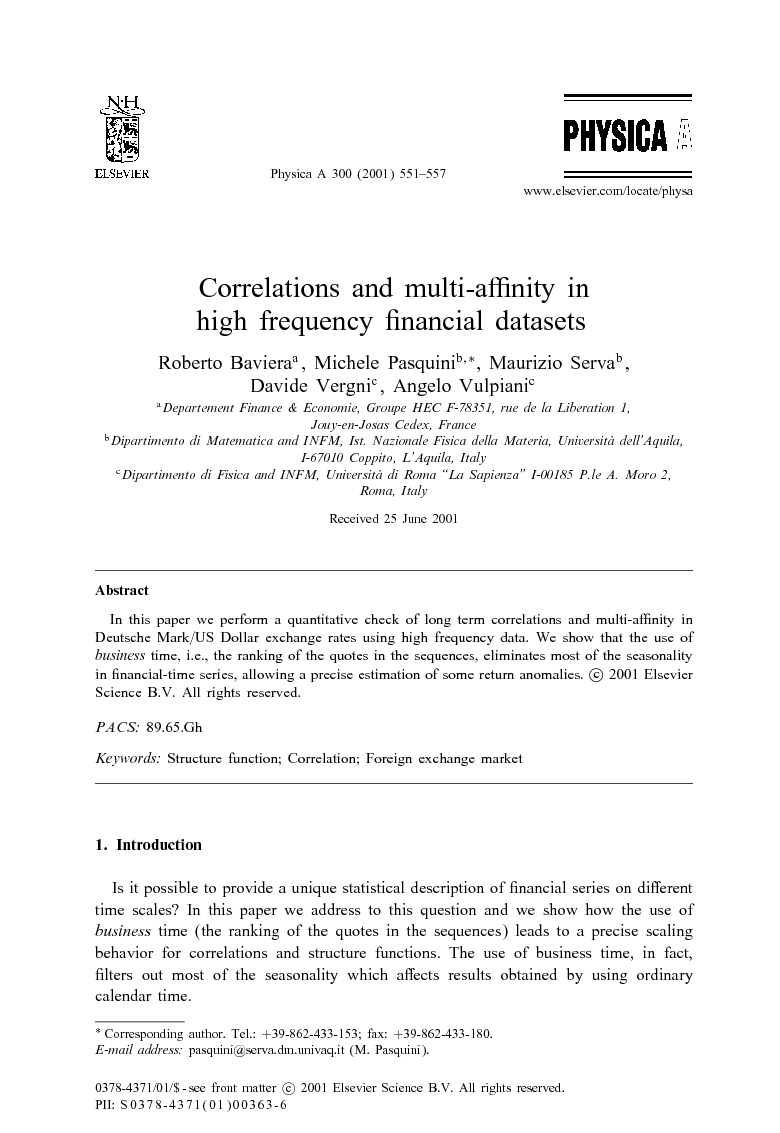In this paper we perform a quantitative check of long term correlations and multi-affinity in Deutsche Mark/US Dollar exchange rates using high frequency data. We show that the use of business time, i.e., the ranking of the quotes in the sequences, eliminates most of the seasonality in financial-time series, allowing a precise estimation of some return anomalies.
Is it possible to provide a unique statistical description of financial series on different time scales? In this paper we address to this question and we show how the use of business time (the ranking of the quotes in the sequences) leads to a precise scaling behavior for correlations and structure functions. The use of business time, in fact, filters out most of the seasonality which affects results obtained by using ordinary calendar time.
We focus in this paper on lags longer than few minutes (where returns are no longer correlated), but shorter than two weeks (after which statistical meaning is lost): in this sense we deal with long term return anomalies. Recent research on low frequency data has pointed out that absolute returns not only exhibit long range power law decaying correlations [1], [2], [3] and [4], but that the typical exponent is not unique [5].
Currency exchange seems to be the natural subject for a statistical description. In fact, the foreign exchange (FX) involves thousands of market participants and there are not a privileged role in the market, such as the specialist in an equity market (New York Stock Exchange [6]). Furthermore, the FX is a very liquid market, and since there is an high competition between brokers, prices cannot be easily manipulated. Finally, it is a worldwide never-closing market and then no opening/closing procedures occur.
For these reasons we have decided to analyze a one-year high frequency data set of the Deutsche Mark/US Dollar exchange, the most liquid market. Our data, made available by Olsen and Associates, contains all worldwide 1,472,241 bid–ask Deutsche Mark/US Dollar exchange rate quotes registered by the inter-bank Reuters network over the period Oct. 1, 1992 to Sept. 30, 1993.
The presence of correlations in Deutsche Mark/US Dollar exchange returns is a well-known fact. For example De Jong et al. [7], who consider the same data set we use, show that returns are negatively correlated for about View the MathML source. Long correlations for absolute returns in FX have been first pointed out by Müller et al. [8], however, results present a strong daily and weekly seasonality. One of the main problems in tick data analysis, in fact, is the irregular spacing of quotes [8], [9] and [10].
In this paper we try to characterize some statistical properties common to the whole sample, rather than to focus the attention on daily or intra-daily patterns. Therefore, also in order to minimize the effects of seasonality, we consider business time. This seems to be a reasonable way to consider time in a worldwide time series, where long lags are due to geographical reasons. In this way we obtain the same statistical behavior at different scales, which is also stationary over all the financial series, since the same power law decay for three order of magnitude in time is observed.
The paper is organized as follows. In Section 2, a structure functions analysis shows that, it is not possible to rescale properly the distribution functions at different lags [11]. In Section 3, we perform a direct independence test, using powers of absolute returns. In Section 4, we summarize and discuss the results.
In this paper we have considered the long term anomalies in the Deutsche Mark/US Dollar quotes in the period from October 1, 1992 to September 30, 1993. We have shown the presence of long term anomalies with two techniques: structure functions and a generalization of the usual correlation analysis.
In a round-the-clock market, business time allows one to avoid most of the seasonality in the results: the same statistical features are obtained for three orders of magnitude in time (between few minutes and two weeks) and are stationary over the sample.
In particular, we have pointed out that an exponential decay in autocorrelations, as suggested by ARCH and GARCH models to explain the clustering of volatility, cannot describe the power law behavior observed in autocorrelations.
Furthermore, we have shown that “random walk” models (or other uni-fractal models) cannot describe these features. The new approach allows to distinguish clearly uni-fractal and multi-fractal behavior (different scaling of different absolute returns), while the usual one (based on the use of calendar time) fails in detecting a different exponent in the decay of autocorrelations for absolute value and squared returns (See e.g. Ref. [8]).
In conclusion, since most of the seasonality is filtered out, structure functions and generalized correlations are very clearly computed, and therefore business time seems to be the proper unit of time in FX markets.


